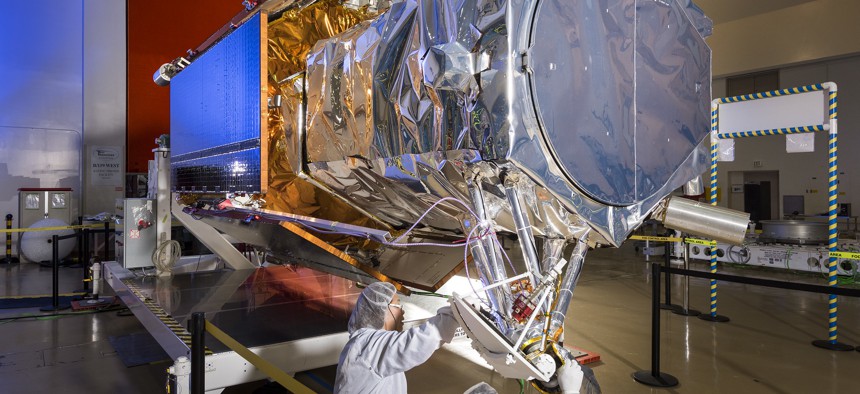
Employees at Lockheed Martin complete final preparations of the WorldView-4 imaging satellite as the team prepares for the upcoming launch at Vandenberg Air Force Base. Lockheed Martin
Pentagon Wants to Build One Satellite Per Week
Over the next two years, the Space Development Agency is looking to put dozens of satellites into orbit.
One satellite per week. That’s what the Pentagon wants industry to provide under its plans to orbit seven new constellations — each with a different function — by the end of 2020.
The satellites would be smaller (“a few hundred kilograms”), cheaper (about $10 million each), and shorter-lived (about five years) than today’s typical military satellites, which can weigh tons and consume billions of dollars but which are expected to operate for decades.
“We are talking [about] technology that is available to fly within 18 to 24 months,” Derek Tournear, director of the Space Development Agency, said during a Tuesday briefing at the Pentagon.
Dubbed the National Defense Space Architecture, the program is the first big initiative of Tournear’s brand-new agency. It aims to orbit “several dozen satellites” through 2022, and then keep going, launching dozens of additional satellites every two years, he said.
The initial NDSA satellites would improve the military’s ability to detect and strike objects like surface-to-air missile launchers. Others would detect and track hypersonic missiles, and pass the data to earthbound missile interceptors.
“In [fiscal 2026], we’ll have full global coverage,” he said.
The Space Development Agency Tuesday announced seven of the new constellations it plans to build. These include:
- Transport: reliable communications between U.S. forces around the world.
- Battle Management: to provide command and control.
- Tracking: to find and track enemy missiles, including hypersonic ones.
- Custody: to keep tabs on enemy ground launchers and other mobile targets.
- Navigation: to augment or replace GPS.
- Deterrence: to deter hostile action in “deep space” — i.e., from geosynchronous Earth orbit to the moon.
- Support: to connect ground-based satellite systems, including launchers.
The Pentagon said it would begin soliciting bids for the first of the new satellites in the “late spring.” and award contracts in the summer.
Tournear said he’s looking for “companies that are going to give us a good solution that we can believe their cost and schedule metrics. I’m open to any and all proposers.”
The creation of the Space Development Agency, which is currently part of the Office of the Secretary of Defense, has been controversial. Air Force leaders have questioned its necessity. The U.S. Space Force, which is part of the Air Force, is expected to assume oversight of the Space Development Agency in late 2022.




